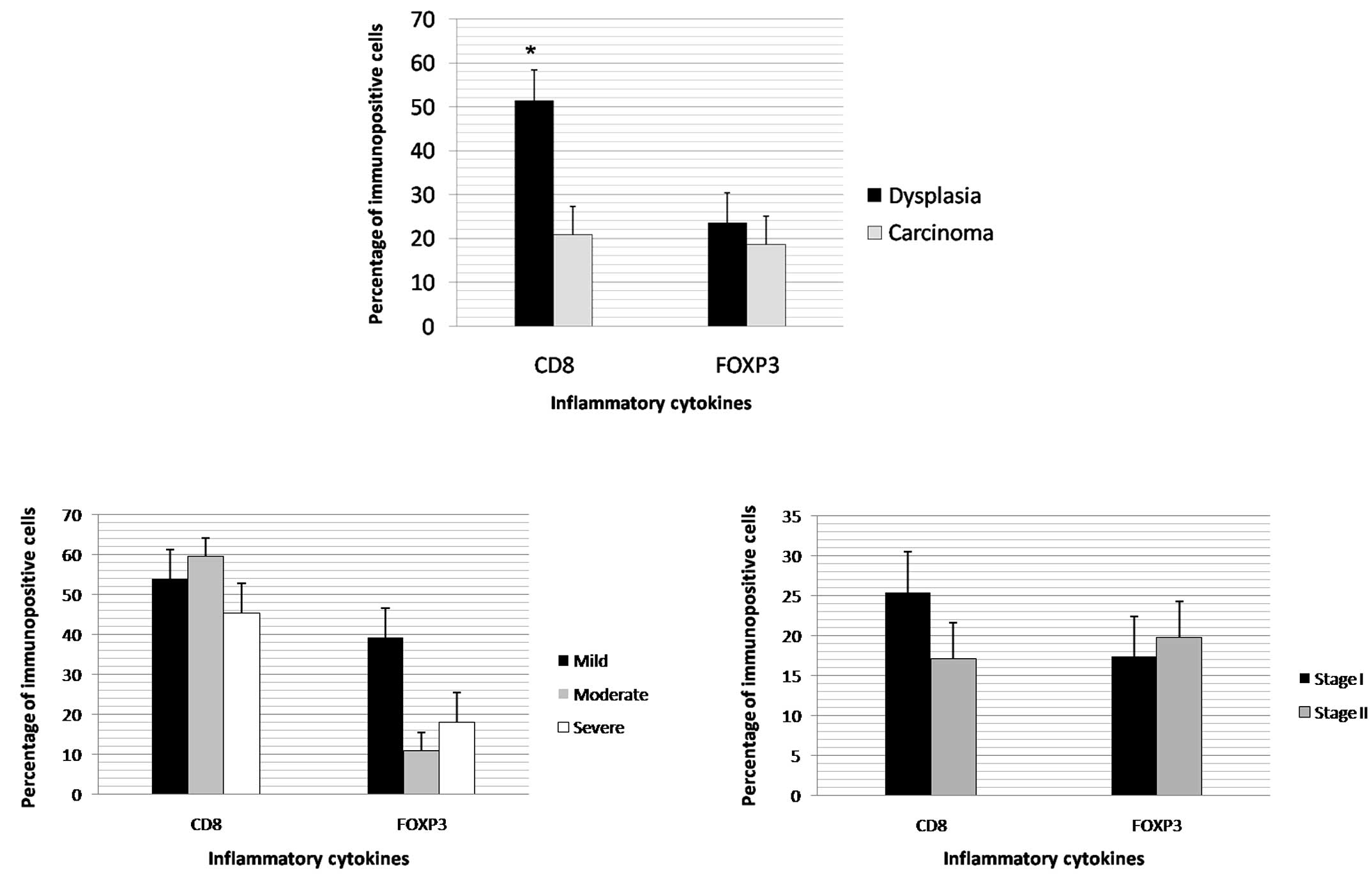|
1
|
Kurokawa H, Zhang M, Matsumoto S,
Yamashita Y, et al: The high prognostic value of the histologic
grade at the deep invasive front of tongue squamous cell carcinoma.
J Oral Pathol Med. 34:329–333. 2005. View Article : Google Scholar : PubMed/NCBI
|
|
2
|
Broders AC: Squamous-cell epithelioma of
the lip: a study of five hundred and thirty-seven cases. J Am Med
Assoc. 6:656–664. 1920. View Article : Google Scholar
|
|
3
|
Broders AC: The microscopic grading of
cancer. Surg Clin North Am. 21:947–961. 1941.
|
|
4
|
Wahi PM: Tipos histológicos de tumores
orales y orofaringeos. Ginebra: Organización Mundial de la Salud;
1971
|
|
5
|
Jakobsson PA, Eneroth GM, Killander D,
Moberger G and Artenson B: Histologic classification and grading of
malignancy in carcinoma of the larynx (a pilot study). Acta Radiol
Ther Phys Biol. 12:1–8. 1973. View Article : Google Scholar : PubMed/NCBI
|
|
6
|
Crissman JD, Liu WY, Gluckman JL and
Cummings G: Prognostic value of histopathologic parameters in
squamous cell carcinoma of the oropharynx. Cancer. 54:2995–3001.
1984. View Article : Google Scholar : PubMed/NCBI
|
|
7
|
Anneroth G, Batsakis JG and Luna M: Review
of the literature and a recommended system of malignancy grading of
squamous cell carcinoma. Scand J Dent Res. 95:222–249.
1987.PubMed/NCBI
|
|
8
|
Bryne M: Is the invasive front of an oral
carcinoma the most important area for prognostication? Oral
diseases. 4:70–77. 1998. View Article : Google Scholar : PubMed/NCBI
|
|
9
|
Costa Ade L, Araújo RF Júnior and Ramos
CC: Correlation between TNM classification and malignancy
histological feature of oral squamous cell carcinoma. Braz J
Otorhinolaryngol. 71:181–187. 2005.PubMed/NCBI
|
|
10
|
Da Silveira EJ, Miguel MC, Lima KC, de
Freitas RA, de Morais ML and Queiroz LM: Analysis of local immunity
in squamous cell carcinoma of the tongue and lower lip. Exp Mol
Pathol. 88:171–175. 2010.PubMed/NCBI
|
|
11
|
Sabel MS, Hess SD, Egilmez NK, Conway TF
Jr, Chen FA and Bankert RB: CTLA-4 blockade augments human T
lymphocyte-mediated suppression of lung tumor xenografts in SCID
mice. Cancer Immunol Immunother. 54:944–952. 2005. View Article : Google Scholar : PubMed/NCBI
|
|
12
|
Chang MC, Chiang CP, Lin CL, Lee JJ, Hahn
LJ and Jeng JH: Cell-mediated immunity and head and neck cancer:
with special emphasis on betel quid chewing habit. Oral Oncol.
41:757–775. 2005. View Article : Google Scholar : PubMed/NCBI
|
|
13
|
Curiel TJ, Coukos G, Zou L, et al:
Specific recruitment of regulatory T cells in ovarian carcinoma
fosters immune privilege and predicts survival. Nat Med.
10:942–949. 2004. View
Article : Google Scholar : PubMed/NCBI
|
|
14
|
Sato E, Olson SH, Ahn J, et al:
Intraepithelial CD8+ tumor-infiltrating lymphocytes and
a high CD8+/regulatory T cell ratio are associated with
favorable prognosis in ovarian cancer. Proc Natl Acad Sci USA.
102:18538–18543. 2005.
|
|
15
|
Fontenot JD, Gavin MA and Rudensky AY:
FoxP3 programs the development and function of
CD4+CD25+ regulatory T cells. Nat Immunol.
4:330–336. 2003. View
Article : Google Scholar : PubMed/NCBI
|
|
16
|
Fontenot JD, Rasmussen JP, Williams LM,
Dooley JL, Farr AG and Rudensky AY: Regulatory T cell lineage
specification by the forkhead transcription factor FoxP3. Immunity.
22:329–341. 2005. View Article : Google Scholar : PubMed/NCBI
|
|
17
|
Weitzman SA and Gordon LI: Inflammation
and cancer: Role of phagocyte-generated oxidants in carcinogenesis.
Blood. 76:655–663. 1990.PubMed/NCBI
|
|
18
|
Balkwill F and Mantovani A: Inflammation
and cancer: back to Virchow? The Lancet. 85:473–483. 2001.
|
|
19
|
Coussens LM and Werb Z: Inflammatory cells
and cancer think different! J Exp Med. 193:23–26. 2001.
|
|
20
|
O’Byrne KJ and Dalgleish AG: Chronic
immune activation and inflammation as the cause of malignancy. Br J
Cancer. 85:473–483. 2001.
|
|
21
|
Yan L, Zucker S and Toole BP: Roles of the
multifunctional glycoprotein, emmprin (basigin; CD 147), in tumour
progression. Thromb Haemost. 93:199–204. 2005.PubMed/NCBI
|
|
22
|
Mignona MD, Fedele S, Lo Russo L, Lo Muzio
L and Bucci E: Immune activation and chronic inflammation as the
cause of malignancy in oral lichen planus: is there any evidence?
Oral Oncol. 40:120–130. 2004. View Article : Google Scholar : PubMed/NCBI
|
|
23
|
Aggarwal BB, Shishodia S, Sandur SK,
Pandey MK and Sethi G: Inflammation and cancer: How hot is the
link? Biochem Pharmacol. 72:1605–1621. 2006. View Article : Google Scholar : PubMed/NCBI
|
|
24
|
Vigneswaran N, Beckers S and Waigel S:
Increased EMMPRIN (CD 147) expression during oral carcinogenesis.
Exp Mol Pathol. 80:147–159. 2006. View Article : Google Scholar : PubMed/NCBI
|
|
25
|
Warnakulasuriya S, Reibel J, Bouquot J and
Dabelsteen E: Oral epithelial dysplasia classification systems:
predictive value, utility, weaknesses and scope for improvement. J
Oral Pathol Med. 37:127–133. 2008. View Article : Google Scholar
|
|
26
|
Abbas NF, Labib El-Sharkawy S, Abbas EA
and Abdel Monem El-Shaer M: Immunohistochemical study of p53 and
angiogenesis in benign and preneoplastic oral lesions and oral
squamous cell carcinoma. Oral Surg Oral Med Oral Pathol Oral Radio
Oral Endod. 103:385–390. 2007. View Article : Google Scholar : PubMed/NCBI
|
|
27
|
Hoffmann TK, Bier H and Whiteside TL:
Targeting the immune system: novel therapeutic approaches in
squamous cell carcinoma of the head and neck. Cancer Immunol
Immunother. 53:1055–1067. 2004. View Article : Google Scholar : PubMed/NCBI
|















